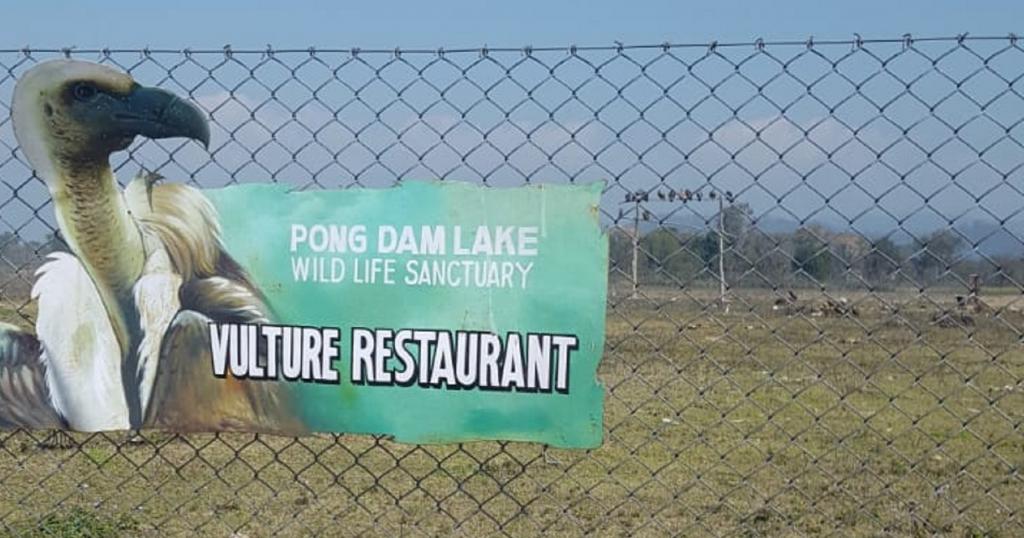RESTAURANT FOR VULTURES!

There are many types of restaurants all over the world starting from ethnic to fast food serving a variety of food both vegetarian and non-vegetarian for people. But this one in Himachal Pradesh is totally different. It serves vultures and naturally the food is raw meat.
The ‘Vulture Restaurant’ — established at Sukhnara in Kangra district of Himachal Pradesh. This vulture restaurant is also managed not by any hotelier or food chain company but by the state forest department’s wildlife wing! As required for its customers, the vulture restaurant does not cook the food. Instead, it allows the local people to bring their dead pets and livestock as food for vultures. Since the vultures are wild it runs during the daytime only.
One may wonder why a restaurant that too for vultures. Vultures usually don’t travel long distances for food. Instead, they rise to expand their field of vision. Their excellent eyesight allows the critically endangered species to scan the landscape below from a relatively static aerial position. Being natural scavengers, vultures are found all over the world and have for a long time, suffered from rapid urbanisation and deteriorating climate.
Their population all over has dwindled as an increase in man-made activities reduced their food sources. Scientists said diclofenac, an anti-inflammatory used to treat disease in cattle that can be fatal to scavengers feeding on their carcasses, was likely to blame for pushing them to the brink of extinction. There are also threats from poachers and farmers.
The Himachal Pradesh government had sought to protect the dwindling number of vultures way back in 2004, when figures revealed there were only 26 vulture nests with 23 baby vultures in a wetland area. Then the state government officials decided that only a natural habitat could save the species. Four years later the state Government established this vulture restaurant and the number increased to 387 nests, carrying 352 baby vultures in 2019. Eight of the world’s 16 vulture species — including the Himalayan vulture and European vulture — have been sighted at the restaurant. The creation of the restaurant gave an impetus to the conservation of vultures in the area. Participation of the local population in conservation efforts also increased because of the ‘restaurant’. It also helped researchers study vultures in close quarters.

The concept of a vulture restaurant is, however, not a new one. The first such restaurant was created in South Africa in 1966. Inspired by this concept, similar restaurants were created in several other countries in Asia, Africa, Europe and even the United States. Of all the countries Spain and Switzerland lead with maximum vulture restaurants followed by South Africa, India and Nepal.
But vulture restaurants became a sustainable way to dispose of aging animals. The hide is sold to a local craftsman to make leather products. Any bones left once the vultures have had their fill go into poultry feed. Vulture restaurants have become the site of ecotourism activities. In many cases, tourists pay a fee to enter a viewing area and watch the vulture restaurants and observe the wildlife that gather there. This can have benefits for encouraging conservation, spreading awareness of threats to vultures, and reducing conflict between vultures and nearby human population. These benefits have updated the image of a bird locals once saw as a carrier of disease and harbinger of death. Getting involved in their conservation has helped communities understand that far from spreading pestilence, vultures efficiently dispose of carrion that could otherwise incubate diseases like rabies and anthrax and contaminate water supplies.
But these operations face some criticisms as well. The practice of prioritizing tourist access to these locations may lead to inappropriate sites being used as restaurants, such as areas near powerlines where vultures may have collisions or areas close to human populations where vultures may interfere with livestock operations. Initially, locals everywhere were wary, especially in India and Nepal where cow slaughter was banned. In Nepal, its national animal is the cow and is considered sacred by predominantly Hindu communities. Vulture itself is considered untouchable and its sight deemed to be omen of bad luck though gods like Sani rides on it.
Despite initial abhorrence, animal cafes have slowly become popular across the globe. There are cat cafes, bunny hotels and even dog spas. Some restaurants have also been declared as “pet friendly”. Similarly, ‘vulture restaurant’ will one day be accepted by common people.
Source: Himalayan News Chronicle
















टिप्पणीहरू